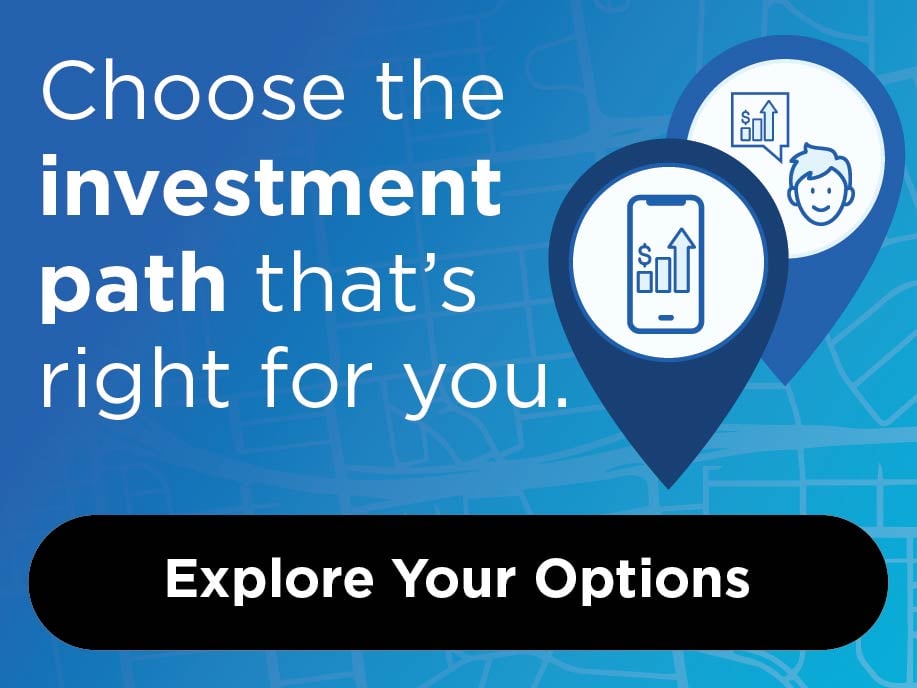
You don’t need to be an expert or have a lot of money to start investing — you just need to begin. Investing gives your money a chance to grow and helps you move closer to your goals, whether that’s retirement, buying a home, paying for education, or simply gaining more financial flexibility.
With a thoughtful plan and consistent effort, you can build confidence and create a stronger financial future.
The Mindset First—Ask These Questions
Before you start investing, take a moment to think about where you are and what matters most to you. A little reflection can help you feel more confident as you take your first steps:
- What’s your time horizon?
Are you investing for retirement in 30 years, or a shorter-term goal like 5 or 10 years? Defining your time horizon will help you choose the type of investment and level of risk you’re willing to take. - How much risk are you comfortable with?
All investing involves risk. You need to find a balance between growth potential and your willingness to weather market swings. - What are your goals?
Is this money for retirement, buying a home, or building an emergency fund? Clarity on your goals can help you choose appropriate investments. - What’s your starting point?
Do you have debt? Do you have an emergency fund saved? Having some stability before leaning into investing can help to reduce stress and risk.
Where to Invest: Common Account Types
- 401(k) or employer-sponsored retirement plans
If your employer offers one, this is often a great place to start. Contributions can come out of your paycheck, and many employers offer matching contributions. - Traditional or Roth IRA
An Individual Retirement Account (IRA) is a tax-advantaged savings account designed to help individuals set aside money for retirement. Unlike an employer-sponsored plan like a 401(k), an IRA is opened and managed by an individual through a bank, brokerage firm, or financial institution. Roth IRAs let you contribute with after-tax dollars and often make sense if you expect your tax rate to rise. Traditional IRA contributions generally are tax-deductible, which can lower your taxable income in the year you contribute. - Brokerage accounts / taxable investing
These accounts don’t provide special tax advantages, but they offer flexibility — you can invest, withdraw, or change course more freely than in retirement-specific accounts. - 529 College Savings Plans
A 529 plan helps families save for education expenses with potential tax advantages. Funds can be used for college, trade schools, and even K-12 tuition in some cases.
What to Invest In: Basic Building Blocks
- Stocks / equities
Represents ownership in individual companies. They tend to offer higher growth potential — and higher volatility. - Bonds / fixed income
Securities that represent loans to governments or companies. Generally more stable than equities, but offer lower returns compared to stocks. - Mutual funds / index funds / ETFs
Investments that pool money from many investors to buy diversified baskets of stocks or bonds. For many beginners, they are core building blocks because they spread risk. Many robo-advisors use these types of funds to automatically build and manage diversified portfolios based on your goals and comfort with risk. - Cash equivalents / Certificates of Deposit (CDs)
Low-risk, interest-bearing options that can offer stability for short-term goals or as part of your emergency fund. - Other options
There are other options as well, such as annuities and alternative investments. Use these thoughtfully and only when they align with your goals and risk tolerance.
How to Begin: Step-by-Step
- Start small and be consistent
Even $50/month invested regularly can grow meaningfully over time. You don’t need to start big — just start. - Choose a diversified portfolio
Don’t put all your eggs in one basket. Use funds that spread across stocks, bonds, sectors, and geographies. - Review and adjust periodically
As your life changes — age, income, goals — your investments should evolve too. Don’t just “set and forget,” but do avoid overreacting to short-term noise. - Get help when needed
A financial advisor can bring perspective, structure, and accountability — especially when decisions feel intimidating.
The Right Mindset to Carry Forward
The most important step is simply getting started. Building good investing habits — even with small amounts — helps you learn, gain confidence, and make progress toward your goals.
At CommunityAmerica Wealth Management, we believe everyone deserves a clear path to financial peace of mind. Whether you’re looking for a simple, automated way to begin through Guided Investing or want personal guidance from a Wealth Advisor, we’ll meet you where you are and help you start with confidence.




